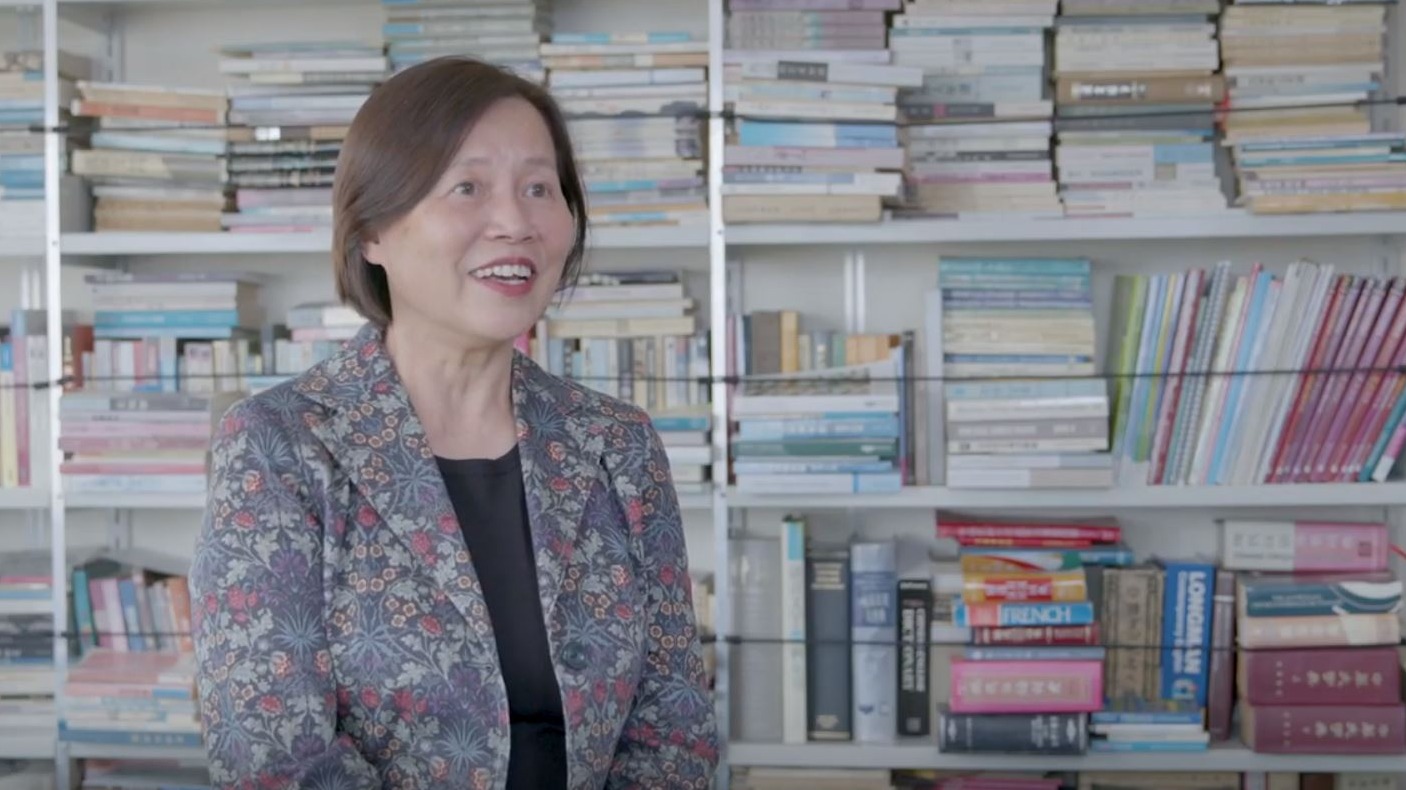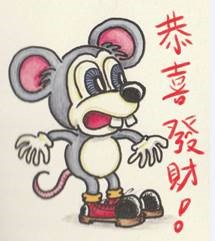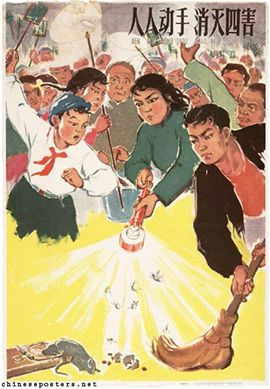2020: Year of the Rat
Professor Yiyan Wang describes an animal with a very split personality and the dissociation between the auspicious golden rats of Chinese social media and the disease-harbouring vermin so hated in Mao Zedong’s China. We also hear a little about her own encounters with Wellington’s most unloved creature.

This year – 2020 – is known as the Year of the Rat by Chinese people all over the world, and has recently been celebrated with public performances, markets, a parade as well as a firework display that dazzled spectators on the Waterfront here in Wellington. We ask Professor Yiyan Wang, currently the acting Head of School at Victoria University of Wellington’s School of Languages and Cultures, to shed some light on the cultural and historical significance of the animal behind these celebrations.
“The Chinese understanding of time used to be more in terms of cycles, rather than linear” as in the European or Christian tradition. The Chinese traditionally name the years, rather than number them. The Chinese system has two 12-symbol sequences, one for the heavenly bodies and one for the earthly beings. The combination of the two sequences forms the names of the years and adds up to a full cycle of 60 years. After a full cycle, the name starts again from the beginning. The 12 symbols for the earthly beings are 子,丑,寅,卯,辰,巳,午,未,申,酉,戌,亥, and became associated with 12 animals, namely rat, ox, tiger, rabbit, dragon, snake, horse, goat, monkey, rooster, dog and pig. One possible reason for the association is that it helps with memorising the sequence, especially for a population once with high illiteracy.
The Chinese attach different meanings to each of the animals, and the interpretations vary from region to region and from time to time. Despite the large variations, those born in the year of a certain animal are usually ascribed that personality or destiny. It can even determine which people would make suitable partners. For instance “the dragon symbolises power, influence and strength and so people say if you are born in the Year of the Dragon it’s best that you don’t marry a tiger, because both tend to dominate with and can lead to unnecessary personality clashes. So, if you are a dragon, it might be better to marry a rat, and you might be more compatible.”
Yiyan says in the Chinese mindset there is a dissociation between the Year of the Rat, and the creatures which scurry around our towns and countryside spreading disease. In Chinese culture "the rat in general seems to be very negative, it’s an animal that people tend to want to get rid of, but when it comes to the Zodiac people don’t mind being born in the Year of the Rat, as the Chinese have a selective association in terms of its connotations. Rats are actually a good sign because, to begin with, rats are very clever, so intelligence, cleverness is something you immediately associate with rats."
“This year I’ve seen many graphic designs that use the golden rat, so the Chinese say 金鼠(jīnshǔ).” She gets out her phone and shows that WeChat, roughly China’s equivalent of Facebook messenger (it has so many more functions), is awash with cute depictions of rats being sent between friends this year. Furthermore, “we have a lot of expressions associated with the golden rat which it makes it more palatable or desirable in a way.”
Interestingly, the Chinese do not make such a distinction between rats and mice. “The Chinese have one character for all different species of rats and mice, this character is 鼠(shǔ)” in pīnyīn, the transliterated representation of the sound of the character used in standard Mandarin Chinese, Yiyan explains. It is only when combined with other characters that it develops a more specific meaning, “you use some pre-modifiers, for instance the little white mice used in medical experiments, the Chinese will call them 小白鼠 (xiăobàishǔ) – literally little white shǔ. In fact these are not as revolting as rats, but on the whole a rat is a rat”. She states that 老鼠(lăoshǔ) can again be a rat or mouse, 米老鼠(milăoshǔ) – or literally rice lăoshǔ – is Mickey Mouse, whereas 大老鼠(dàlăoshǔ) – literally big shǔ – is definitely an filthy rat rather than a cute mouse. Then there is the word for plague 鼠疫 (shǔyì) – which is shǔ plus the word for epidemic. Chinese frequently uses such pre-modifiers to describe new things and concepts and “so kangaroo is 袋鼠 (dàishǔ) which combines the word ‘pocket’ meaning pouch with rat”. In this case鼠(shǔ) is again endearing, rather than repugnant. As it happens Yiyan says the other major threat to conservation here in Aotearoa, the “possum is known as 负鼠(fùshǔ).”
 When asked about what Chinese people in Wellington think about the Predator Free Wellington movement, Yiyan again cites the dissociation between the Zodiac and the pest. “I think they would be very happy, like me, in participating in that movement. In reality, I don’t think Chinese attach any admiration to rats.” Yiyan points out that our war on rats here in New Zealand also has a precedent in China. "The Communist Party launched a campaign to get rid of the four types of animals that had been regarded as harmful by humans...the Chinese called it 除四害 (chúsìhài) or Four Pests Campaign”. This eradication campaign during Great Leap Forward saw a nationwide effort targeting rats, flies, mosquitoes and sparrows between 1958 and 1962. As we have discovered during our own battle to save our flora and fauna from introduced predators such as rats and possums here in New Zealand, taking out one predator from an ecosystem can have unexpected consequences. The “sparrows were regarded as a terrible bird that stole grain from the peasants, so there was a big campaign to get rid of them, but then the crops were eaten by insects as the ecological balance was changed." Many say this exacerbated a severe famine at that time, and so sparrows were substituted for cockroaches Yiyan says.
When asked about what Chinese people in Wellington think about the Predator Free Wellington movement, Yiyan again cites the dissociation between the Zodiac and the pest. “I think they would be very happy, like me, in participating in that movement. In reality, I don’t think Chinese attach any admiration to rats.” Yiyan points out that our war on rats here in New Zealand also has a precedent in China. "The Communist Party launched a campaign to get rid of the four types of animals that had been regarded as harmful by humans...the Chinese called it 除四害 (chúsìhài) or Four Pests Campaign”. This eradication campaign during Great Leap Forward saw a nationwide effort targeting rats, flies, mosquitoes and sparrows between 1958 and 1962. As we have discovered during our own battle to save our flora and fauna from introduced predators such as rats and possums here in New Zealand, taking out one predator from an ecosystem can have unexpected consequences. The “sparrows were regarded as a terrible bird that stole grain from the peasants, so there was a big campaign to get rid of them, but then the crops were eaten by insects as the ecological balance was changed." Many say this exacerbated a severe famine at that time, and so sparrows were substituted for cockroaches Yiyan says.
Closer to home we have focussed firmly on the negative traits of the rat, indeed it has been condemned for thwarting our aspiration to restore Wellington’s dawn chorus. We have seen countless headlines in which the rat is depicted as public enemy number one over the past year, such as 'Monster rats in Wellington the size of small possums’, ‘Making Wellington a predator-free city’, ‘Tracking inner city rats’ and most recently ‘Rats still at large on Miramar Peninsula as 'predator free' 2020 target passes.” This year staff and students here at Victoria University of Wellington are getting in on the action, with a student-led campaign to roll out a trapping network around the Kelburn campus underway. Yiyan too is a member of the nearby Predator Free Brooklyn group and has two traps in her own garden. But as Yiyan says “the rat is known for being clever and resourceful, and of course rats are also very good at reproducing descendants” so though they may be fewer, it seems unlikely that 2020 will be the last Year of the Rat.
Cartoon 恭喜发财! (May you have a prosperous New Year!) a common Chinese New Year's greeting courtesy of Catherine Churchman.
Poster 人人动手消灭四害 (Everybody get to work to destroy the Four Pests) designed by You Longgu (游龙姑) March 1960, part of the IISH / Stefan R. Landsberger / Private Collection.
Article: Benjamin Swale
